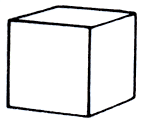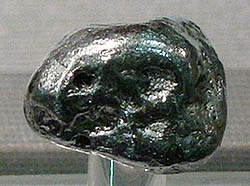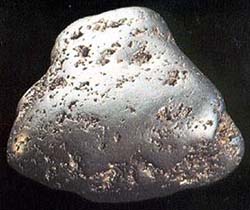Native elements: Platinum
 Diagnostic card.
Diagnostic card.
Pt
Cubic amount of cubic zirconia
Hardness 4-4,5
Specific weight 21,4
Cleavage is absent
Crack irregular
Color gray silver
Color in powder gray
Glitter metal

Platinum (usually with impurities of iron - iridium, osmium, palladium). The gloss is metallic, opaque. Color silver-white. The break is hooked, forging. Cleavage is absent. It is formed in ultrabasic rocks. Accumulates in placers. An important ore mineral of platinum is sperrylite PtAs2. Crystals (cubic syngony) are rare; Usually platinum is represented by rounded grains or tuberous nuggets. It is used mainly for laboratory dishes, in electronics, electrical engineering. Deposits: South Africa, Canada, the Urals, Alaska.
 Native platinum is rarely chemically pure, contains iron (up to 18%), copper, gold and other elements. Well-formed crystals are very rare. Usually there are small grains, scales and nuggets (an exceptional case - a platinum nugget weighing 9 kg).
Native platinum is rarely chemically pure, contains iron (up to 18%), copper, gold and other elements. Well-formed crystals are very rare. Usually there are small grains, scales and nuggets (an exceptional case - a platinum nugget weighing 9 kg).
Native platinum was initially taken as a kind of silver. Platinum for jewelry business is not new at all. Tolk in platinum jewelry knew even the ancient Egyptians: in the excavation of tombs archeologists found the most elegant platinum jewelry. Platinum (English Platinum, French Platine, German Platin), probably, was known in ancient times.
Chemical composition. Platinum (Pt) 79-96%, iron (Fe) 4-21% (platinum and iron can replace each other isomorphically), iridium (iridium platinum) up to 7%, palladium (palladium platinum) 0.1-1% (rarely Up to 7%), rhodium (rhodium platinum) 0.1-0.5% (rarely up to 5%), sometimes in significant quantities there is nickel (nickel platinum). The shape of the crystals. Hexahedral crystals. Crystal structure. A face-centered cube (see Table 1). Poliksen is very similar to native silver and native iron. From silver differs higher hardness and density. Aggregates. Leaflets, grains, clod-like nuggets.
 Diagnostic signs.
Diagnostic signs.
Not affected by any acids, except for "royal vodka" (a mixture of nitric and hydrochloric acid), in the latter can dissolve when heated. Behavior in acids. It dissolves only in royal vodka, that is, in a mixture consisting of one part of concentrated HNO3 and 4-6 parts of concentrated HCl.
Origin.
It is formed in the process of segregation during cooling of the basic and ultrabasic rocks enriched with olivine. It often concentrates with weathering, because it has a high specific gravity, which allows it to accumulate in alluvial placers.
Deposits and applications.
The most important deposits were discovered in 1822 in the Urals (near Perm). Other significant deposits are in Borneo, Ethiopia, South Africa, Canada, Colombia and Australia. Platinum is used in jewelry and in scientific research (a strong catalyst). It is also used in jewelry for the production of expensive jewelry.

Gold-platinum-bearing conglomerate with pyrite pebbles. Witwatersrand, South Africa. Photo: © А.А. Evseev.

Nugget of platinum, small (1692 g). Lower. Tagil (rn), Russia (RF, CIS). Photo: © А.А. Evseev.
- Ghetchellit - "New Almaden blend" - arsenide and antimony sulfide (modern sulfosol)
- Antimony is a toxic metal (semimetal) , widely used in metallurgy, medicine and engineering
- Zirconium - a rare and undiscovered metal and the most dangerous precious stone in oxide and salt
- Gold - yellow dangerous and poisonous metal of modern accurate digital and cable technologies
- Sulfur is a golden-yellow toxic substance and a sign of active volcanic activity
- Cadmium is an undisputed toxic silvery metal unknown to a wide range of people
- Lead - a toxic gray imitator of metallic silver and toxic metal blende
- Arsenic is a classic poison of medieval and modern poisoners and medicine in medicine
Poisonous and radioactive dangerous stones and minerals
** - poisonous stones and minerals (mandatory check in the chemical laboratory + explicit indication of toxicity)
** - radioactive stones and minerals (mandatory check on the standard dosimeter + ban on open sales in case of radioactivity exceeding 24 milli / g / h + additional measures of population protection)
Catalog of minerals and semi-precious stones of the world by groups
** - poisonous stones and minerals
** - radioactive stones and minerals


Comments
When commenting on, remember that the content and tone of your message can hurt the feelings of real people, show respect and tolerance to your interlocutors even if you do not share their opinion, your behavior in the conditions of freedom of expression and anonymity provided by the Internet, changes Not only virtual, but also the real world. All comments are hidden from the index, spam is controlled.